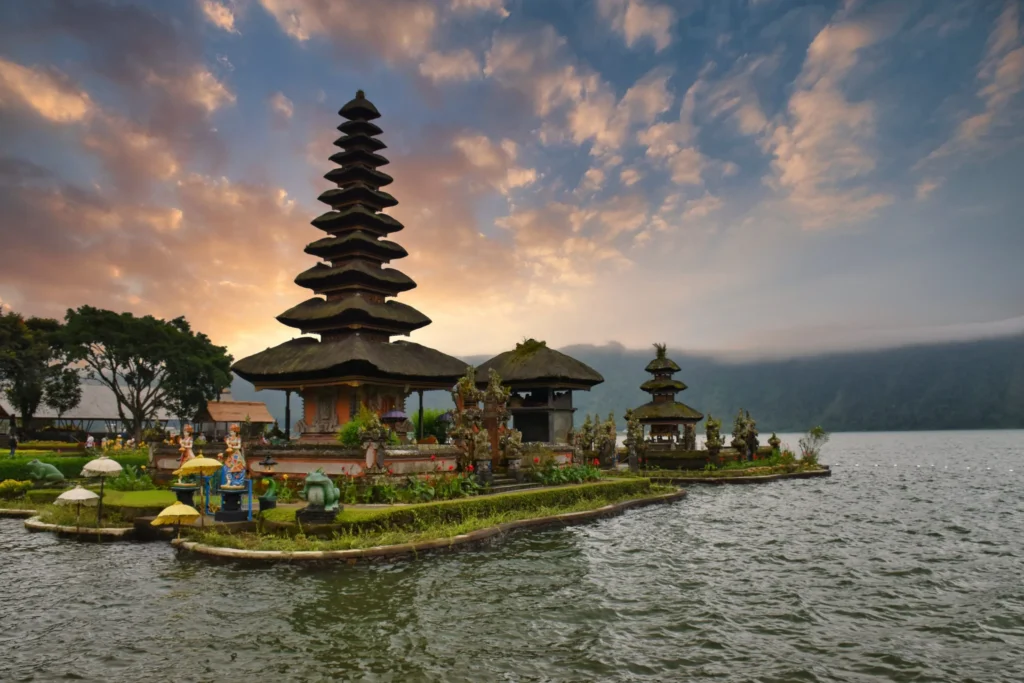Bali, with its tropical charm and inviting landscapes, is a year-round destination. However, understanding the island’s weather patterns can help you make the most of your visit. Bali’s climate is characterized by warm temperatures, seasonal variations in rainfall, and a humid atmosphere, making it essential to plan your activities according to the time of year. Let’s dive into Bali’s weather and what you can expect throughout the year, along with tailored recommendations to enhance your trip.

Overview of Bali’s Climate
Bali has a tropical monsoon climate, which means it experiences two distinct seasons: the dry season and the wet season. The average temperature hovers around 30°C (86°F) during the day and dips to 24°C (75°F) at night, providing consistently warm conditions.
Humidity levels can range from 70% to 90%, making some periods feel more tropical and lush. Coastal areas, such as Seminyak and Kuta, tend to be hotter, while higher elevations in Ubud and the central highlands, such as Munduk, offer cooler and more refreshing climates.
The Dry Season: April to October
The dry season is the most popular time to visit Bali, especially for outdoor enthusiasts and beach lovers. From April to October, the island enjoys sunny days, minimal rainfall, and lower humidity levels, making it perfect for exploration and relaxation.
What to Do in the Dry Season:
- Beach Hopping and Surfing: Visit Uluwatu and Padang Padang beaches for world-class surfing or relax at Seminyak, Jimbaran, or Nusa Dua for golden sands and luxury beach clubs like Finns Beach Club and Sundays Beach Club.
- Trekking and Adventure: Embark on a sunrise trek up Mount Batur to witness breathtaking views or explore the dramatic cliffs and turquoise waters of Nusa Penida.
- Underwater Adventures: Dive or snorkel in Tulamben to explore the USAT Liberty Shipwreck or discover coral reefs and marine life at Menjangan Island.
- Cultural Exploration: Attend the Bali Arts Festival in Denpasar, a month-long celebration of dance, music, and crafts, or visit ancient temples like Besakih and Tirta Empul, known for their spiritual significance.
Seasonal Events:
- Bali Arts Festival (June-July): A vibrant showcase of Balinese culture featuring traditional performances, exhibitions, and parades.
- Galungan and Kuningan (Dates Vary): These religious festivals celebrate the victory of good over evil, with streets adorned with decorative penjor bamboo poles.
The Wet Season: November to March

The wet season brings higher humidity and frequent, though often brief, rainfall. From November to March, Bali’s landscapes become even more vibrant, with lush greenery and flowing waterfalls creating a magical atmosphere.
What to Do in the Wet Season:
- Wellness Retreats: Escape the rain with indoor activities like yoga and meditation in Ubud, or enjoy a traditional Balinese massage at luxury retreats like Como Shambhala or Fivelements Retreat.
- Cultural and Spiritual Experiences: Explore temples like Tanah Lot and Uluwatu, or participate in a purification ritual at Tirta Empul.
- Waterfalls and Nature Escapes: Visit dramatic waterfalls like Sekumpul, Tegenungan, and Gitgit, which are at their most impressive during the wet season.
- Village and Market Tours: Experience traditional cooking classes or shop for handmade crafts and textiles at Ubud Market or Sukawati Art Market.
Seasonal Events:
- Nyepi (March): The Balinese New Year, marked by a Day of Silence, where the entire island observes quiet reflection. The preceding Ogoh-Ogoh parades feature giant demonic effigies carried through the streets.
- Christmas and New Year (December-January): A festive period with special events at resorts and beach clubs.
Tips for Visiting During the Wet Season:
- Plan outdoor activities in the morning, as rain typically falls in the afternoon or evening.
- Pack a compact umbrella, waterproof shoes, and light rain gear for sudden downpours.
Best Times to Visit Bali
April to October: Perfect for outdoor activities, beach holidays, and cultural festivals, this period offers the driest and most pleasant weather. It’s ideal for families, honeymooners, and adventure seekers.
November to March: A quieter time with fewer tourists, the wet season is great for budget travelers and those seeking a more tranquil experience. Despite the rain, the lush landscapes and vibrant festivals make it a magical time to visit.
Seasonal Highlights by Region

- South Bali (Kuta, Seminyak, Nusa Dua):
- Best during the dry season for beaches, nightlife, and luxury accommodations.
- Try parasailing, jet skiing, or dining at upscale restaurants overlooking the ocean.
- Central Bali (Ubud):
- Perfect year-round for cultural activities, wellness retreats, and nature exploration.
- Visit Monkey Forest, enjoy a rice paddy walk, or attend a traditional Balinese dance performance.
- North and East Bali (Lovina, Amed, Tulamben):
- Ideal for snorkeling, diving, and exploring quieter beaches.
- Visit Banjar Hot Springs and the serene Brahmavihara-Arama Buddhist Monastery.
Packing Tips for Bali’s Weather
For the Dry Season:
- Lightweight, breathable clothing for warm days.
- Sun protection, including sunscreen, sunglasses, and a wide-brimmed hat.
- Comfortable footwear for trekking and exploring.
For the Wet Season:
- A compact umbrella or lightweight rain jacket for sudden showers.
- Quick-drying clothing to stay comfortable in humid conditions.
- Waterproof footwear or sandals for navigating wet terrain.
Why Bali’s Climate Adds to Its Charm

Bali’s tropical climate is part of its appeal, creating an ever-changing backdrop that enhances its natural beauty and cultural vibrancy. The dry season highlights its beaches and outdoor adventures, while the wet season transforms its landscapes into a lush paradise, perfect for introspection and cultural immersion.
Whether you prefer sun-soaked days or the sound of tropical rain, Bali’s weather ensures there’s always something extraordinary to experience. With this guide, you’re equipped to enjoy Bali at any time of year. Would you like help creating a customized itinerary or planning specific activities for your trip? Let us know how can we assist further!